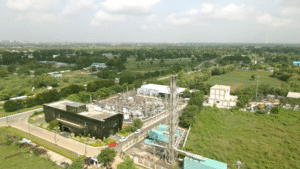Greater Noida (Hridaya Mohan, July 10): In August 2021, while launching the National Automobile Scrappage Policy, Prime Minister Narendra Modi described it as a step toward a “circular economy that will give a new identity to the auto sector and make development more sustainable and environment-friendly.”
The vision was ambitious: reduce pollution, improve fuel efficiency, increase road safety, modernize India’s automobile ecosystem and support green growth. However, the on-ground experience of citizens, particularly in non-metro regions, tells a different story — one of financial burden, infrastructural gaps and uneven priorities.
Circular Economy or Economic Burden?
The scrappage policy’s core idea lies in recycling and resource recovery. Old, inefficient vehicles are to be discarded in favor of new, cleaner ones. Materials such as steel, rubber, plastic and electronics would be recovered, creating a loop that feeds back into manufacturing — the essence of a circular economy.
Importantly, the material composition of vehicles is also shifting in this transition. In conventional petrol/diesel cars,about 60% of the structure is made from steel — a material that is highly recyclable and already part of industrial recovery chains. In contrast, electric vehicles (EVs) use only about 35% steel, replacing it with aluminum, lithium, rare earth metals and complex electronic components. These materials are less recyclable, more energy-intensive to extract and often sourced from environmentally sensitive or geopolitically volatile regions.
While this shift supports vehicle electrification, it also raises questions: Is the circular economy truly circular when core materials are harder to reuse or recover? And is India ready with the industrial capacity to recycle batteries, electronics and e-waste at scale?
But for the average Indian, this grand loop feels more like a one-way push to discard still-useful vehicles. The cost of buying a new one — even after incentives like a Rs. 20000/- rebate and road tax waivers — can exceed ₹5–10 lakh,according to 2022 NITI Aayog estimates. The benefits are insufficient for the average citizen, who may have bought their vehicle with a small loan or years of savings. The scrapping options are also limited or poorly organized in many states.
The burden of initiating this transition falls not on governments or corporations, but on individual citizens — often small business owners, farmers and working-class commuters.
Auto Sector: Will It Truly Get a Boost?
The policy is positioned as a demand stimulus for the Indian automobile industry. After facing a prolonged slowdown between 2018 and 2023, exacerbated by the pandemic and economic uncertainty, the sector is in need of revival.
However, demand doesn’t rise just because older vehicles are scrapped. Many buyers are currently delaying purchases or turning to used vehicles. Additionally, consumer hesitancy around electric vehicles (EVs), lack of charging infrastructure and affordability concerns limit the scope of large-scale renewal.
While the scrappage policy may nudge the auto sector forward, it also demands re-skilling, supply chain adaptation and careful support for legacy industries — or it may trigger displacement rather than growth.
Fitness, Not Age, Should Guide Policy
The current rule mandates that private petrol vehicles be scrapped after 15 years and diesel vehicles after 10,regardless of their condition. This age-based approach is arbitrary and does not reflect the actual roadworthiness of a vehicle.
A car that is well-maintained, lightly used and regularly tested for emissions should not be forced off the road just because it crossed a numerical threshold. By contrast, government-run buses and trucks, often poorly maintained and visibly polluting, continue to operate with little accountability.
Consider Chhattisgarh’s police emergency vans — the “Dial 112” fleet. These were procured in 2017 and have reportedly clocked over 4 lakh kilometers. Yet, as of 2025, they remain fully operational. If such high-mileage emergency vehicles can function reliably, why should a private car with less than 60,000 km in 15 years is labelled unfit?
A striking case emerged recently from Delhi. Beginning July 1, 2025, the city enforced a fuel ban on older vehicles — fuel stations were instructed not to supply petrol or diesel to vehicles that had crossed the age limit. Many vehicles were also seized on the spot. The sudden move left daily wage earners, small transporters and ordinary commuters stranded and anxious. Facing public outcry and operational chaos, the Delhi government had to request the Commission for Air Quality Management (CAQM) to withhold action against such vehicle within days who agreedto put on hold the decision up to November 1, 2025. The Chief Minister, Delhi mentioned that her Government is considering filing a review petition in the Supreme Court against the irrationality of declaring vehicles “end-of-life” based solely on age. This illustrates how poorly planned enforcement can backfire when it lacks infrastructure or social cushioning.
Clearly, scrappage should be based on scientific fitness testing, not blanket age restrictions. Without a functional network of automated vehicle testing centers, such aggressive measures risk eroding public trust and causing avoidable distress.
Public Transport and Infrastructure: The Missing Links
The success of scrappage and renewal policies depends not just on supply-side incentives, but on viable alternatives for mobility.
According to a 2021 report from the Ministry of Housing and Urban Affairs, less than 18% of urban commuters in Tier-2 and Tier-3 cities use public transport. In such areas, auto-rickshaws, scooters and small cars are the only mobility options.
Without massive investments in clean, affordable public transport, many families are left with a painful choice: either keep an “unfit” vehicle and risk penalties — or go without transportation altogether.
A Global Reality Check
While private vehicle owners are being pushed toward scrappage, much larger global polluters often remain conspicuously exempt from environmental accountability.
Take war, for instance. The Russia–Ukraine war alone generated around 230 million tonnes of CO₂-equivalent emissions between February 2022 and early 2025 — roughly equal to the emissions of 120 million passenger cars running for a day or annual emissions of 45 million cars. These emissions arise from explosions, troop movements, fuel burn and infrastructure destruction — yet war-related emissions are excluded from climate treaties like the Paris Agreement.
Closer still, the Israel–Hamas conflict in Gaza an estimated 1.89 million tonnes of CO₂-equivalent emissions were generated between the 7 October 2023 Hamas attack and the temporary cease fire in January 2025 — mostly from Israel’s aerial bombardment and ground invasion. These emissions came not just from weaponry and military fuel use, but also from the destruction of buildings and essential infrastructure, which will now require carbon-intensive reconstruction.
Despite the scale of these emissions, global climate policy discussions often remain silent on war as a polluter, while national-level policies target individual citizens using older personal vehicles.
And What About India?
Back home, parali (stubble) burning contributes up to 40% of Delhi’s winter pollution as per SAFAR and IIT-Kanpur studies. Add to that the unchecked construction dust, industrial emissions, thermal power plants and aging state-run fleets — many of which escape scrutiny due to regulatory gaps or political compromise.
According to the Central Pollution Control Board, vehicular emissions account for about 10–15% of urban pollution. A 2019 TERI study found that old diesel trucks and commercial vehicles, though small in number, cause up to 70% of vehicular PM emissions.
Yet, the policy focus falls disproportionately on the private citizen’s 15-year-old car, often used for commuting, education or livelihood. It suggests a narrow lens of environmental accountability — targeting those easiest to penalize, not those most responsible.
A Smarter Way Forward
The path to cleaner air and a circular economy doesn’t have to come at the cost of equity and logic. A smarter, phased approach could include:
- Fitness First: Shift from age-based bans to mandatory pollution and roadworthiness testing, especially for personal vehicles.
- Green Retrofitting: Offer subsidies or credits for retrofitting old vehicles with greener technology or fuel kits.
- Expand Public Transit: Invest rapidly in affordable, clean public transport, particularly in Tier-2 and Tier-3 cities.
- Recycling Infrastructure: Build robust battery, electronics and e-waste recycling hubs, especially as EV adoption grows.
- Target High-Impact Sectors: Prioritize action on industrial emissions, government fleets and public workspollution before burdening citizens.
Sustainability must not be top-down punishment — it must be built as a social contract, grounded in fairness and scientific rationale.
Mobility Is Not a Luxury — It’s a Lifeline
For most Indians, a vehicle is not a vanity item. It is a livelihood tool, a last-mile connector, a means of dignity and independence.
Yes, India needs clean air and modern industry. But that transformation must be inclusive, equitable and based on realistic timelines. Otherwise, in the name of green growth, we risk scrapping the very mobility of the poor.
Let us build a scrappage ecosystem that truly recycles — not just materials, but benefits across society.
About the Author

Mr. Hridaya Mohan (hridayamohan@yahoo.co.in) is a regular Columnist with a renowned Indian daily “The Hitavada”, “Bharat Neeti Media” and some other newspapers / magazines internationally. Superannuated as Executive Director, Steel Authority of India Ltd. (SAIL), he is Senior Adviser, Metallon Holdings Pvt. Ltd. presently. He headed SAIL office at Beijing as Chief Representative (China & Mongolia) for six years. He has published and presented seventeen papers globally. Recipient of “Sir M Visvesvaraya Gold Medal”for one of his papers, “Benchmarking of Maintenance Practices in Steel Industry” from The Institution of Engineers (India), he was awarded with “Scroll of Honour” for the excellent contributions to Engineering fraternity from IE(I), Bhilai, “Jawahar Award” for leadership excellence in SAIL and “Supply Chain Leader – 2017” award from IIMM.









